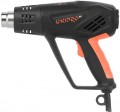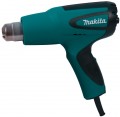Power consumption
The power normally consumed by the building dryer during operation. This parameter primarily determines the scope of the tool, as well as its performance, temperature and heating rate: more powerful models are better suited for large volumes of work, they produce a more intense air flow (see "Maximum Productivity") can be heated to higher temperatures and heating up is faster. At the same time, it must be taken into account that high power also has a downside: heavy weight, large dimensions and high cost of the tool, as well as a serious load on the power grid and significant electricity consumption. Therefore, when choosing by this parameter, it is worth proceeding from what work it is planned to use a hair dryer for and how important high power is for them. And don't forget about other features. After all, even the most powerful tool will be useless if it cannot provide, for example, the required temperature.
Fan speeds
The number of fan speeds provided for in the adjustments of the heat gun. The intensity of blowing the workpiece, or rather the amount of air supplied and the pressure of the air flow, depends on the fan speed. And since different jobs require different intensities of air supply, the more speeds a hair dryer has, the more versatile it is, the easier it is to adjust its parameters for certain tasks. Most modern models have
2 – 3 speed adjustments, however, there are also very simple single-speed options, and even advanced devices with smooth adjustment, which allows you to select the fan speed as accurately as possible for a specific purpose.
Temperature adjustments
The number of outlet air temperature adjustments provided for in the design of the heat gun. The adjustment itself is an almost mandatory function for such a tool — after all, different types of work and different types of materials require their own temperature values, and without it you can either “underheat” or “burn through” the workpiece. The more adjustments provided in the design of the hair dryer — the finer the temperature settings, the easier it is to choose the mode that is optimal for a particular task. At the same time, it is worth noting that in this case we are talking about
step temperature control, while the most advanced option today is smooth control (see below).
Minimum heating temperature
The lowest air temperature that a heat gun can produce when operating in normal mode, in other words, the lower limit of the operating temperature range. Accordingly, the lower this limit, the wider the range, ceteris paribus, and the more versatile the tool: after all, for different jobs and temperatures, you need different ones. Some modern hair dryers have the ability to "cold" blowing, without heating.
Max. heating temperature
The highest outlet air temperature that a hair dryer can provide. As with the minimum temperature, this parameter determines how wide the operating range of the tool is and for what range of work it can be used. High operating temperatures are important not only for refractory materials — they can significantly speed up the processing of large surfaces. On the other hand, it is worth considering that for strong heating, appropriate power is required, which affects the weight, energy consumption, and often the price of the hair dryer.
Stepples t° control
The ability
to smoothly change the temperature of the air supplied by the heat gun. The meaning of temperature adjustments is generally detailed in the relevant paragraph above; here we note that smooth adjustment has a number of advantages over stepped. The main one is that the outlet temperature in such hair dryers can be adjusted very precisely, and at will, and not in accordance with the fixed values \u200b\u200bthat are set in the manufacturer's settings. Among the disadvantages of this option, one can note a higher cost than most step regulators — despite the fact that in fact high tuning accuracy is not required so often, usually in professional work.
Cold air mode
This option allows you to completely turn off the heating element, leaving only the fan running, or reduce the heating temperature to a minimum of 50 °C.
The cold air mode is necessary for cooling heated parts. For example, a stream of cold air will allow you to quickly cool the seams of hot melt adhesive. Most often, the cold air mode is represented by a separate position on the temperature mode switch, while cold air will be carried out at one single speed. But some models allow you to turn off the heating element by hardware, in which case cold blowing can be carried out in a wide range of speeds.
Display
The presence of its own
display in the design of the heat gun. Usually, this is the simplest black-and-white LCD screen for 3-4 characters, sometimes with additional graphic indicators. However, even such a screen significantly increases the ease of management, making it more informative. Various additional data can be displayed on the display, both basic (temperature, fan speed, etc.) and auxiliary (for example, error notifications). At the same time, screens are inexpensive, so they can be found even in low-cost-level heat guns.
In box
—
Case. Cases are special containers designed for storing and transporting tools. Typically, such containers are made in the form of characteristic suitcases made of hard materials, with handles for easy carrying on the outside and nests for tools and accessories inside. In addition to protecting the contents from adverse effects (dust, moisture) and contact with foreign objects, such suitcases also perform another important function: they allow you to keep the hair dryer and its accessories in one place, reducing the risk of losing any of these items. . Improvised packages can also be used for such tasks; however, complete cases tend to be more practical and convenient.
—
Scraper. Availability of a scraper in a set of delivery of the heat gun. The scraper is used in the processing of various surfaces, mainly to remove old paint, dirt, etc. The working part of such a tool has the form of a small plate, the edge of which scrapes over the surface to be treated.
It should be noted that in this case, it is the traditional hand-held scraper held by the user during operation. Among heat guns, there are often nozzle attachments that have a similar purpose, but they are not included in this category. Returning to the hand tool, we note that in some situations it turns out to be more convenient than a hair dryer with a nozzle. First of all, such devices are noticeably lighter and more compact, whic
...h makes them very convenient for working in hard-to-reach places, as well as for work that requires precision and accuracy. Also, a hand scraper can be useful if the surface to be treated does not require heating.
— Spatula. The presence of a spatula in the delivery set of a heat gun. A spatula is a tool resembling a small spatula — it consists of a plate (most often metal) and a handle. This tool can be used for different purposes. So, in some cases, it can serve as a replacement for a scraper — a spatula can easily cope with putty, wallpaper and other coatings that do not require too intense exposure. Another popular use of such devices is the application and leveling of various coatings, primarily putty (which got its name from the spatula).
It is worth noting that in this case, the presence of a traditional manual spatula in the kit is implied; there are nozzle attachments for a similar purpose, but in this case they are not considered spatulas. In some situations, a hand tool is much more convenient than a hair dryer with a nozzle. So, the classic spatula has a small size and weight, thanks to which it handles well with work in hard-to-reach places, as well as where precise and accurate action is required. Also, this particular tool is best used in cases where the surface to be treated does not need to be heated with a hairdryer.
— Nozzles. The number of additional nozzles per nozzle supplied with the building dryer.
Interestingly, in this case, the most extensive configuration option is most popular — 4 pcs. This is due to the fact that nozzles are inexpensive, and thanks to them, the capabilities of the hair dryer are noticeably expanding. A smaller number — 2 pcs, 3 pcs, is noticeably less common, 5 pcs and more — almost never occurs.
Note that the design and purpose of the nozzles can be different, so these details should be clarified in each case separately. Traditional options include a constrictor nozzle, a reamer nozzle, a scraper nozzle, and a spatula nozzle. The purpose of the first two varieties is clear from the name — they are designed to configure the flow of hot air to suit the particular situation. Thus, the narrowing of the flow allows you to increase the intensity of the impact and reach hard-to-reach places, and the expansion speeds up the processing of large surfaces for which productivity is important. As for the last two types, they should not be confused with hand scrapers and spatulas (see the relevant paragraphs): we are talking about nozzles that are put on the nozzle. They are similar in application, but they have their own specifics of work: the metal plate (the working element of the scraper / spatula) is bent so that the hot air flow from the hair dryer is directed to the surface in front of the working edge of the plate. Thus, the spatula / scraper moves over the heated surface, which greatly facilitates processing.
